The crocheted turban has become an elegant accessory in oriental style. The hat is perfect for evening and casual wear.. It can be worn in cold and warm weather, depending on the type of threads used in the description of the knitting pattern. Having a turban in your wardrobe can diversify a large number of outlooks, giving outfits a new style in the off-season and in winter. Thanks to its simple design, it is easy to knit it yourself.
Features of knitting a turban
A crochet turban (the diagram and description will be presented below) is made on the basis of a simple pattern. If desired, it can be supplemented with various knitting options - elastic, openwork edging or sides. Patterns that make the headdress unique and fashionable are also possible.

The model of this hat is almost always knitted using one pattern, since the design is based on the creation of a wide fabric:
- The knitted rectangle is usually folded in a certain way and secured with a brooch.
- A knitted scarf can be used as a base. A great solution for those who want to save time.
- You can sew the edges in different ways - each new seam creates a specific shape of the turban fit.
- One-piece knitted models will require precise head measurements.
- The patterns are designed taking into account increases and decreases so that the model fits perfectly on the owner.
- You can also create an unusual turban based on a simple knitted turban.
If for some reason the basic blanks are not suitable, you can pay attention to patterns and diagrams. They will help create the perfect image of the oriental style. The main thing is that the turban matches the outerwear. To do this, it is important to pay attention to the patterns, fit models, patterns and type of yarn.
Materials and tools
To create any turban model, you will need yarn and a hook. For warm models, it is better to choose thick, dense threads so that the headdress does not let in cold air. As a rule, all labels contain information about the knitting density and the appropriate hook number. Also, a metal tool with a rubber or plastic handle will be more convenient than its analogues.
It is worth abandoning aluminum and plastic bases for the following reasons:
- Plastic hooks quickly become deformed, which affects the convenience of work.
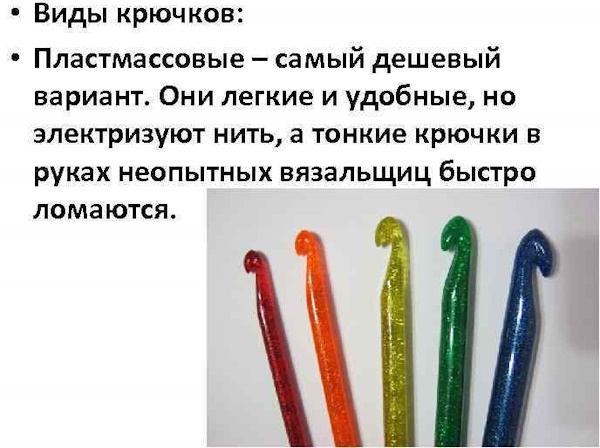
- Aluminum tools are quite light and therefore wear out faster, giving in to bending.
- Some coatings on the tool handle may wear off over time.
- If the hook is made of low-quality materials, there is a risk of roughness. It is because of them that the yarn sometimes gets caught on the hook, after which snags appear.
- Bamboo models are highly durable, lightweight and have a pleasant finish.
- Cheap plastic bases can rub against your fingers, causing calluses on your hands after prolonged knitting.
It is important to choose the right hook size. For thick yarn, hook #4-5 is usually suitable. Yarn volume can vary from 200 m for 100 g.
What yarn to choose for knitting
A crochet turban (the diagram and description describe in detail the features of choosing materials for work) can be knitted from yarn of different density and thickness. Yarn made of 100% wool is suitable for creating a warm hat.
It is also acceptable to use wool blends with mohair, alpaca or angora. The most affordable option is wool with admixtures of viscose and acrylic. It is necessary to take into account the quality of the threads, since wear resistance will vary depending on the manufacturer and the % ratio of wool in it.
Depending on the type of yarn and its composition, the consumption will vary:
- To create a winter hat you will need natural wool yarn with mohair or angora.
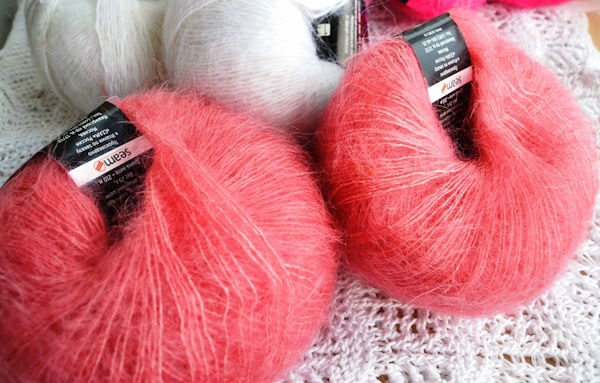
- For the warm season, linen, cotton thread or threads with viscose admixtures are suitable.
- The thickness of the yarn can vary - 100 g of yarn/200 m for simple patterns, for openwork patterns - up to 500 m/100 g.
- Density - the higher it is, the warmer the product will be. Density also affects the formation of patterns.
Before buying yarn, you need to accurately calculate the material consumption, taking into account the pattern and head size.
How to determine the size of the product
As a rule, before starting knitting, craftsmen create a sample measuring 10*10 cm to understand what the density of the fabric will be and what yarn consumption will be for a complete product.
| Density | You can determine this by counting the number of columns and rows for every 5 cm of fabric. |
| Density for 1 cm (openwork knitting) | Each parameter from the previous step must be divided by 5 to obtain the knitting density calculation for 1 cm of fabric. |
| Height | The parameters from step 2 must be multiplied by the height of the product in cm. |
| Number of loops | The number of loops for the parameter from step 1 must be multiplied by every 5 cm of the repeating pattern. |
To knit you need to know 2 main measurement parameters:
- head depth — measure the distance from point A (frontal lobe location of the hat) to point B (occipital point location of the edge of the hat);
- head volume - measure the circumference of the head at its widest part.
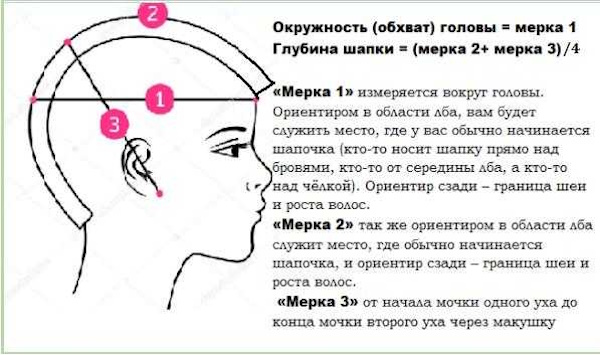
The figure shows the types of measurements for calculating the main indicators when creating a turban. The resulting head volume should be multiplied by the density of columns in the sketch for each 1 cm of fabric. As a result, you will get the number of air loops for the set in the first row. For the best fit of the product on the head, it is customary to add 2 cm to the obtained parameters.
Turban headband - simple model
The turban pattern is a regular headband, which is made using the “elastic” technique. Some descriptions provide detailed measurements for this model. For work, you will need 160 m of yarn, taking into account the standard head volume of up to 56 cm, hook No. 3.5, scissors and a needle. First, you need to hook 23 VP and 1 loop for lifting.
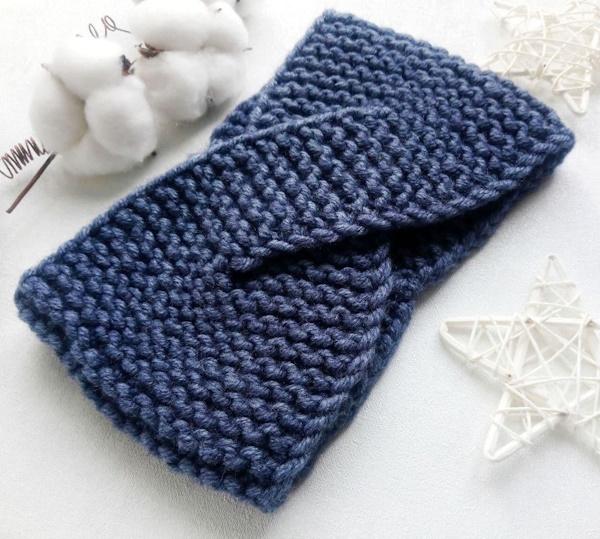
Further according to the scheme:
- It is necessary to knit the 1st row with half-columns with 1 yarn over.
- In the 2nd row you need to knit a lifting loop and until the end of the row - st. with 2 yarn overs.
- Then you should unfold the fabric and knit a row of loops with yarn overs without columns.
- Again, you need to unfold the fabric and knit 2 VP for lifting.
- Then you should knit 1 front relief column.
- In the same row you need to make 1 purl relief st.
- Subsequently, it is necessary to alternate 2 front relief sts and 1 purl st to the end of the row. At the end, as at the beginning, you will get 2 front relief sts.
- The fabric needs to be turned again and continue knitting, repeating the pattern of the previous row until you reach 18 rows of 20 cm.
- Then the knitting should be divided into 2 equal parts of 11 VP. Purl relief. st. in the middle of the knitting should not be knitted.
- Each half of the pattern needs to be knitted with an additional 10 rows for 10 cm.
- The threads should be cut at the end of the rows and secured.
- In the 2nd half of the fabric you need to knit 1 relief st. additionally to get a total of 23 st.
- Both halves need to be crossed together, then knit according to the pattern 23 sts, adding 18 rows in each row for 18 cm.
- When the rows are knitted, the end of the thread needs to be cut, leaving a length of 26 cm.
- The edges of the product must be sewn together using a needle.
This turban model can be knitted from 100% Naturafil merino wool. Its consumption for 100 g is 45 m, or 90 m for 50 g.
Turban hat - diagram and description
There is another option for knitting a simple turban model.
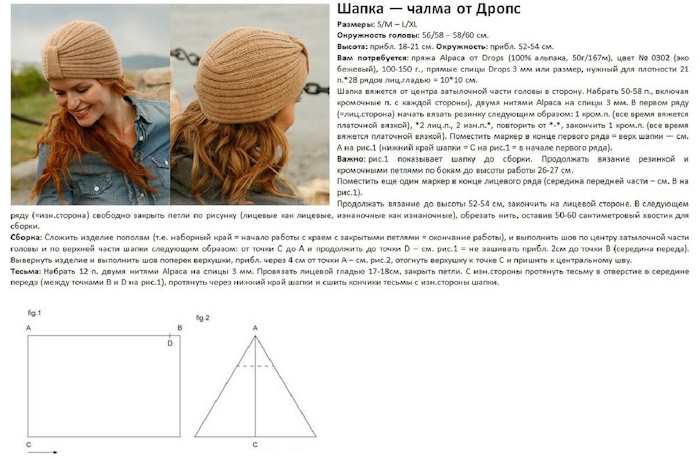
To create it, you need to immediately connect a long chain of VP:
- Cast on 158 VP, then in the 1st row knit a single crochet.
- In the 2nd row, you need to knit a single crochet into each previous loop until the end of the row.
- Next you need to repeat the pattern for 10 rows.
- To round off the corners, you need to knit decreases from the 13th row: for every 2nd row, do not knit 1 VP 3 times, then 2 VP 2 times and 3 VP 1 time.
- The length of the product with rounded edges is 90 cm, the height is 12 cm.
- The fabric needs to be folded in half, turning one half inside out.
- At the back, you need to mark the middle of the turban, and connect the edges from the center to the crown.
- Using a needle, you need to sew all the parts together.
- Having formed the crown, the turban needs to be turned inside out.
- The top seam needs to be sewn together.
- The ends of the threads should be hidden and stitched along the edges of the product.
This turban can be complemented with a brooch or decorative ornament.
Openwork turban
A turban with openwork knitted inserts will become not only a comfortable and warm headdress, but also a beautiful addition to any outfit. The main thing is to choose a good color of yarn that would match many elements in the clothes.
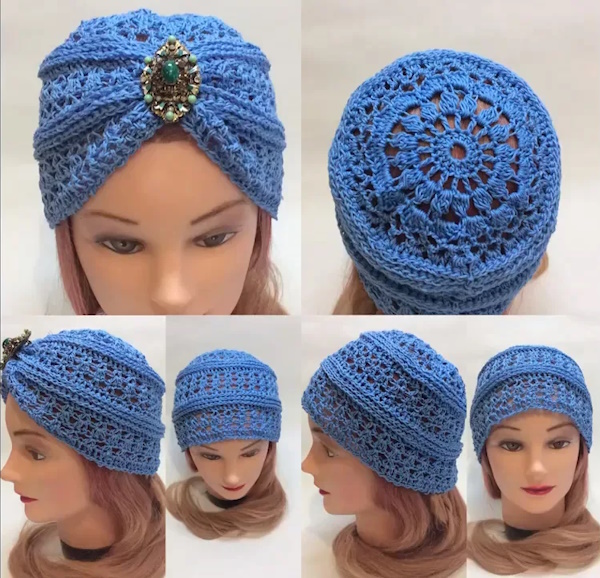
For work you will need cotton or wool yarn:
- First you need to create a ring of 3 VP. The middle needs to be knitted using 5 dc. without a yarn over.
- Further knitting will be accompanied by increases to expand the fabric.
- In the 1st row, you need to knit 3 VP for lifting and continue: 1 dc, 3 VP, 1 dc from the same previous VP from the bottom row. Next, you need to knit 5 dc from one VP. The pattern needs to be repeated until the end of the row, alternating the patterns.
- In the 2nd row, you need to knit 2 VP, then continue the row: 5 dc, 1 dc, 3 VP and 1 dc. Repeat the pattern until the end of the row, alternating the pattern. It is repeated in the opposite direction, as in the previous row.
- In the 3rd row you need to repeat the pattern of the 1st row.
- Next, upon reaching the desired expansion, knit according to the pattern to the highest point of the forehead: 3 knit stitches, alternating with 1 purl stitch.
- The knitting needs to be divided into 2 equal parts and continue knitting according to the pattern, starting from the center of the fabric.
- Gradually the edges need to be rounded off by making decreases.
Knitting pattern:
- For 31 VP you need to knit in the 1st row 3 front sts, 1 purl st, and another 3 front sts.
- The pattern must be repeated until the end of the row.
- Next, you need to knit 1 front st, 3 front sts, repeating the pattern to the end of the row.
- Next, the 1st and 2nd rows must be repeated to the end of the fabric according to the pattern.
For the pattern, you can take separate yarn from silk and wool 60/40% for 50 g per 180 m.
Voluminous turban
A crochet turban (the diagram and description allow you to accurately repeat the pattern, but you need to take into account the parameters of the measurements) can be knitted from large yarn, which is suitable for creating warm hats. For work, you will need 300 m / 100 g of wool, hook No. 4 and a knitting diagram. The work will use lush columns with yarns. They are created using a set of 1 VP of the previous row of several yarns without knitting, after which the VP is knitted into the 5th next loop from the initial one.
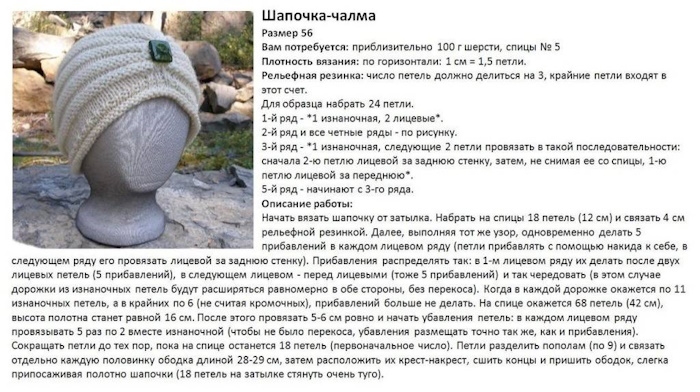
Process:
- First, you need to make a chain of VP and knit it in the 1st row with lush st. with a tilt.
- Having knitted the required number of rows, you need to assemble the turban according to the assembly pattern. The edges need to be sewn together, and the blank should be decorated with a brooch or decor.
- To make the necessary seams, you need to turn the turban inside out.
- The threads should be hidden at the end of the rows, as well as after sewing on all the decorations.
This model is made quickly due to the presence of lush and voluminous stitches. If the product is made of thin yarn, the lush columns should be made smaller to maintain the effect of volume.
Made from plush yarn
Since plush yarn has a high density and thickness, the product turns out to be quite large. Moon Farm Moonshine yarn from Juniper is suitable for work. The composition includes 45% wool, 40% alpaca and 15% silk. To create a turban, you will need up to 200 m / 150 g of yarn.
For a circumference of 50 cm and a height of 23 cm, you will need to knit a fabric with a density of up to 28 VP per 10 cm of the sample. Since the yarn is voluminous, its stretch will be higher for 50 cm of length compared to other types of yarn.
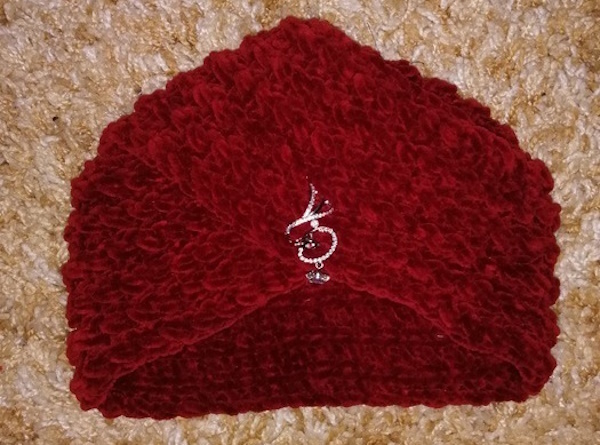
Process:
- For this job you will need the largest hook that will fit the thickness.
- The pattern will feature the Mobius effect - the knitting method is similar to the pattern for circular knitting needles.
- First, you need to cast on 92 VP for circular knitting, closing the circle.
- In the 1st main row you need to knit 4 VP, knit stitches to the end of the row and additionally 1 VP to transition to 1 purl stitch.
- In the next 2 rows you need to knit the same pattern, adding to each row the pattern *2 knit stitches, 4 VP + 1 stitch for lifting*.
Next, you need to break the thread with a margin of 18 cm. With the remaining thread, you need to sew the hole formed at the beginning of the fabric. Then you need to work the front side using the Mobius turn method so that the edges of the product are closed at the top, forming a small ring. The edge remains even. To create a cross under the crown area, you need to work 19 loops of the front. p.
At the point of lifting under the crown, you need to knit 2 VP, fixing the turn of the threads. To close the knitting, you need to hide the thread from the wrong side. The edge can be left unknitted, but you should sew the loops with a needle and thread.
Curvy shape
Also popular is the Alize Cotton Gold yarn, which is presented in a rich color palette. The composition includes 55% cotton and 45% acrylic. The turban model is suitable for cool autumn or spring. Hook No. 3 is suitable for such threads. For a head circumference of 59-64 cm, you will need 300 g / 190 m.
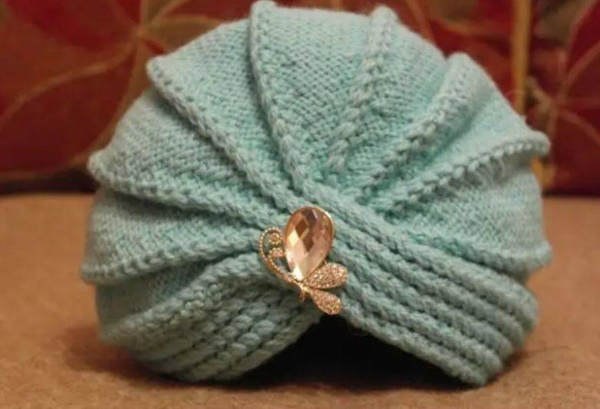
Process:
- First, you need to dial 28 VP and knit 7 turning rows with alternating relief and purl loops using the technique of a column with a yarn over.
- Starting from the 8th row, knit according to the pattern: 3 VP for lifting, 1 front relief. DC, 1 purl relief. DC, 1 front relief. DC; and continue the pattern by repeating *1 VP, 1 purl relief. DC, 1 VP, 1 simple relief. front DC*. Repeat to the end of the row 9 more times, ending the 10th arch with 3 VP.
- Next, in each row after the pattern diagram, you need to alternate in the last 3 loops - 3 VP for lifting, 1 out. relief. DC, *pattern: 1 VP, on the VP over the front relief. DC*, then knit front and out. p. DC, finishing the rows with DC and VP for lifting in the next row.
- Knit according to the pattern up to the 9th row, then: 3 VP, 1 purl relief. DC, 1 front relief with a yarn over. In the 9th row, make a pattern according to the pattern *1 VP in the loop above the relief front DC and knit DC*. Then finish the pattern with an increase in the form of front relief. DC. The row should be finished with a back relief VP. Repeat the pattern to the end of the row.
- In the 10th row, repeat the pattern from the 9th row 8 more times, then knit 1 purl and front relief. DC, then move on to the pattern in the arches. To move, knit 1 purl relief. DC and DC in the 3rd loop for lifting.
- Next, in the arches, you need to make an increase: knit a DC from the previous row in the form of a purl relief. DC between VP for 2 purl relief. DC.
- In the 11th row, over each arch, knit over 1 VP from the inside. relief. DC for one DC and 2 front relief. DC.
- In the 12th row, make all loops with yarn overs for each arch. Fasten the loops with purl sts with yarn overs.
- Next, for each purl row, you need to knit an increase with a yarn over. For the front rows, cast on and knit purl relief CCHs.
- Through the purl and face relief. SSN is necessary to achieve the number of arches up to 7 pcs. instead of 10.
- In 20 rows you need to knit 11 cm of pattern.
- Then you need to knit according to the pattern without increases until the 42nd row.
- In the 43rd row, it is necessary to knit the decreases with relief VP with a yarn over. To do this, for each arch, make 2 front relief. CCH with a single vertex. From the first front relief, do not remove 2 VP, but knit them to the end through front relief. CCH.
- When there are 4 VPs left on the hook, they should be knitted together and finish the row with edge sts.
- In the 44th row, you should knit 2 purl. VP relief. type from the last arches, but with one peak. They need to be knitted together.
- In subsequent rows, you need to knit decreases in the same way in the purl and face rows.
- In the 54th row you need to knit a purl relief st between the arches with VP, and in the 55th row you need to make 28 relief CCHs with an elastic band without VP.
The remaining side parts of the turban need to be knitted in two parts with 2 DC in front relief. DC, as well as front relief. DC for front rows with edge purl relief. DC in purl rows.
Made of mohair
A crochet turban (the diagram and description for thick threads are presented below) will look good if it is knitted from mohair. This is angora yarn, which is considered the softest and warmest after wool. Airy fibers allow you to create voluminous patterns for lightweight headwear. Due to the density, you will need a hook No. 6, since the yarn is quite fluffy. For a turban, you will need up to 250 m / 110 g.
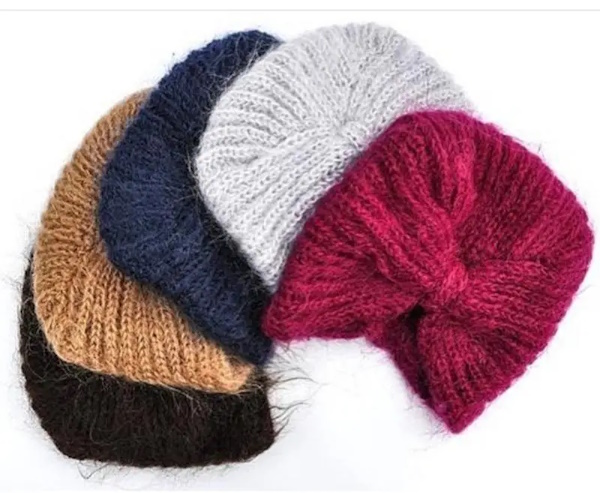
Process:
- First you need to dial 20 VP and knit the first row of VP without a yarn over.
- Next, you need to knit another 30 rows behind the back wall with half loops, all sc.
- The resulting fabric should be divided into 2 equal parts. Knit 10 sc separately for 25 rows.
- The first part ends on the outside of the turban, the second on the inside. The thread should not be cut; it must be threaded to the inside to continue knitting.
- Both halves of the turban need to be crossed over each other, and then knit another 34 rows with the main pattern.
When the pattern is finished, both parts of the headdress need to be sewn together with a needle and thread so that the edge of the seam is facing the wrong side.
With a pattern
Almost any turban can be knitted with elements of the pattern. There are also patterns that allow you to create a turban hat only from the main pattern according to the pattern. The model is presented in two variations, since you can wear it with either side facing your face. For a girth of 54 cm, you will need twisted yarn 120 g / 200 m, yarn of a different color for the edge and hooks No. 5 and No. 3.
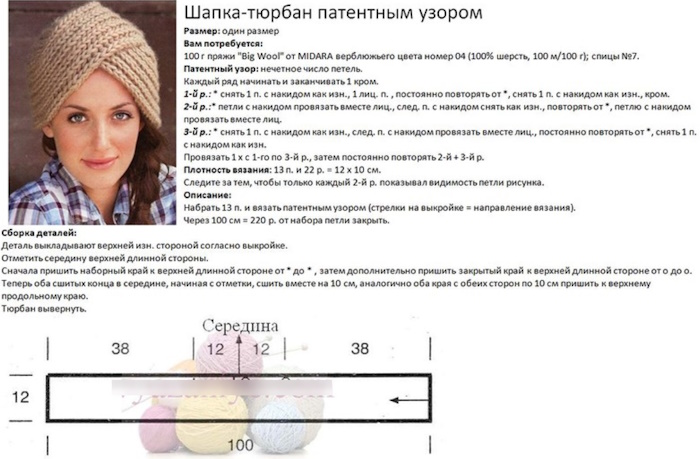
Process:
- Basically, you need to dial a VP of 32 cm in length, then knit 5 cm VP to decrease 2 VP on both sides. 1 VP will remain in the center.
- At the end of all rows, 10 cm of fabric should be left knitted.
- Then in the following rows you need to make decreases according to the shape of the head - 3 VP, starting from the 6th row, 4 VP from the 7th row and so on until the 12th row of the product. The remaining VP should be closed with edge loops.
- Then you should fold the fabric in half and knit 3-4 folds, starting from the top edge.
- The edge of the turban needs to be processed: 6 dc for each 7th VP from the previous row.
If desired, you can replace the pattern with a more lush and ornate one:
- The twisted pattern will require 42 working VP - 34 in length and height. In the rapport, a square of the pattern scheme is formed by 10-12 cm.
- In the 1st row, knit 1 VP, 1 purl st, then repeat the pattern: *1 purl st, remove 1 VP and knit with hook No. 3, close the pattern with 1 purl st* to knit st without a yarn over.
- In the 2nd row you can knit only knit stitches, or alternate 1 purl stitch and 2 knit stitches.
- All finished rows should be closed with 15 VP. For 12 cm of fabric, you need to knit twisted loops and shift the seams to the back of the head.
The finished turban should be sewn along the seams on the wrong side. Additionally, you can decorate the product with a ribbon or sequins.
A turban made of thin or thick threads will always remain an element of Eastern fashion in the wardrobe. If you don’t have a diagram or description at hand, you can refer to basic knowledge, trying to knit a rectangle. It can be easily crossed, creating a beautiful decoration for a new outfit.
Crochet technique also allows you to combine several different styles and patterns in one piece.
Video about crocheting a turban
Master class on crocheting a turban:
